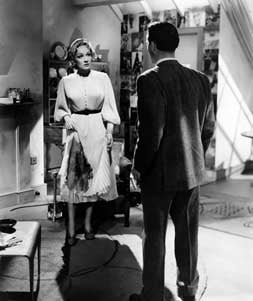 KINGSTON, R.I. – Nov. 19, 2013 – It’s an iconic scene in cinematic history: Marlene Dietrich making a grand entrance in Alfred Hitchcock’s Stage Fright. But all eyes are not on the sultry German actress. It’s her billowy Dior dress that’s grabbing all the attention, especially the hideous bloodstains marring the white silk.
KINGSTON, R.I. – Nov. 19, 2013 – It’s an iconic scene in cinematic history: Marlene Dietrich making a grand entrance in Alfred Hitchcock’s Stage Fright. But all eyes are not on the sultry German actress. It’s her billowy Dior dress that’s grabbing all the attention, especially the hideous bloodstains marring the white silk.
In the lexicon of film theory that’s called “cinematic negative wardrobe,” an idea that Jonathan Faiers, a writer, lecturer and artist from England, will discuss during a talk at the University of Rhode Island next month.
His talk, “Dressing Dangerously: Dysfunctional Fashion on Film” will start at 7 p.m. Thursday, Dec. 5 in Room 271 at Chafee Hall on the Kingston campus. The talk is free and open to the public.
“Clothes signal meanings, and we are looking forward to having Jonathan Faiers decode those meanings for us,” said Linda Welters, professor and co-chair of URI’s department of Textiles, Fashion Merchandising and Design. “All are welcome to the talk.”
Faiers is a lecturer in fashion theory at Winchester School of Art, University of Southampton, in England. He obtained his doctorate in the representation of museum space in cinema from the University of London. His work explores the relationship between popular culture, textiles, and dress.
 His latest book, Dressing Dangerously: Dysfunctional Fashion in Film, shows how clothes play key roles in shaping the narrative of a film. The book also explores how film influences fashion and how fashion speaks to film.
His latest book, Dressing Dangerously: Dysfunctional Fashion in Film, shows how clothes play key roles in shaping the narrative of a film. The book also explores how film influences fashion and how fashion speaks to film.
The book reveals how clothing in a film can be used to elicit emotions in such a way that the dress becomes part of the movie’s narrative, or text. He argues that this role of clothing has been largely overlooked – until now.
“Most studies of clothing in film concentrate on the set piece outfit, the dress or suit that projects unachievable glamour and instills longing,” he said in a recent article. “Film is, in fact, far more often filled with items from what I have termed negative cinematic wardrobe, a closet full of unworn, lost, stolen, and damaged items familiar to us all.”
Examples, he said, include the satin mule wedged under a frayed stair rug as a catalyst for self-destruction in John M. Stahl’s Leave Her to Heaven; the stained glove in Robert Wise’s The House on Telegraph Hill; and the incandescent whiteness of the hate-mongering William Shatner in Roger Corman’s The Intruder.
Faiers is also the author of Tartan, which explores the cultural significance of the cloth and its development through history from clanship to contemporary fashion. Depending on the era, the fabric could be considered aristocratic, sexually suggestive, or even punk.
In addition, Faiers has explored in his papers, lectures, and conferences knitting and formlessness, the fashion designer Balenciaga and ecclesiastical dress, Classicism, fashion and science fiction, tweed and gender subversion, and criminality and tailoring. His installations as a visual artist have centered on the Kashmir shawl and Huguenot silk weaving.
Pictured above:
Jonathan Faiers, an internationally known writer, lecturer and fashion theorist, will give a talk at 7 p.m., Thursday Dec. 5 in Chafee Hall at the University of Rhode Island. The talk is called, “Dressing Dangerously: Dysfunctional Fashion on Film.” Photo courtesy of Jonathan Faiers.
Marlene Dietrich holding up her bloodstained dress in Alfred Hitchcock’s Stage Fright, as she utters, “Johnny, Johnny! Do you love me? Say that you love me.” Photo courtesy of URI professor Linda Welters.

